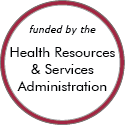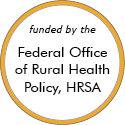Rural Project Examples: Children and youth
Other Project Examples
The Walking Classroom
Updated/reviewed March 2023
- Need: To increase students' levels of physical activity, engagement in learning, and academic achievement.
- Intervention: With The Walking Classroom, students take a brisk walk as a group while listening to a kid-friendly, custom-written educational podcast that aligns with the curriculum.
- Results: Children increase their activity level while learning academic content, building health literacy, and developing healthy lifestyle habits to prevent obesity and improve cognitive function and retention.
Health-e-Schools

Updated/reviewed October 2022
- Need: Rural school children lack proper healthcare resources within the school setting.
- Intervention: Health-e-Schools provides health services to students via telehealth using video conferencing and special equipment.
- Results: Health-e-Schools increases access to primary healthcare, increases attendance in the classroom, and decreases the amount of time that parents or guardians must take off of work to bring their child to health-related appointments.
Wisconsin Early Education Shared Service Network
Updated/reviewed October 2022
- Need: Throughout the state of Wisconsin, childcare services are closing rapidly, with staffing and finance issues as the main causes.
- Intervention: In Wisconsin's Monroe and Vernon Counties, a collaborative that focuses on addressing key childcare access issues has come up with a creative solution. The Wisconsin Early Education Shared Services Network allows childcare providers to pool staff, resources, and services while receiving support for business and educational operations.
- Results: As of September 2022, 25 childcare programs in Monroe and Vernon Counties have joined WEESSN and more are considering. Joining has allowed childcare providers to focus their time, finances, and energy on the children they serve.
Rescue Divas EMT Recruitment
Updated/reviewed June 2022
- Need: Increased number of emergency medical technicians in rural northern Wisconsin.
- Intervention: Creation of a program, Rescue Divas, for middle school girls to spark interest in emergency medical services careers.
- Results: Post-participation results demonstrate the camp increases interest in an emergency medical services career.
The Adolescent Pre-Diabetes Prevention Program

Added October 2018
- Need: Prevention of type 2 diabetes in adolescents living in rural parts of Louisiana.
- Intervention: Through screenings, the Adolescent Pre-Diabetes Prevention Program detects the onset of prediabetes. Through nutrition and physical activity education, the program teaches high school students and staff how to adopt healthy lifestyles.
- Results: The program has seen an increase in enrollment and continues to see decreases in body weight, body mass index, and A1C levels among participants.
For examples from other sources, see:
